
| ||||
|---|---|---|---|---|
 |
 |
 |
 |
 |



























| ||||
|---|---|---|---|---|
 |
 |
 |
 |
 |


























North American YF-107A Ultra Sabre
Single-Engine Single-Seat Low-Swept-Wing USAF Supersonic Tactical Fighter-Bomber Design Competition Prototype/small>

Archive Photos 2, 3
North American YF-107A Ultra Saber (NA-212, AF 51-5118) on display 10/20/1993 at the Pima Air and Space Museum, Tucson, Arizona (Photo by John Shupek)
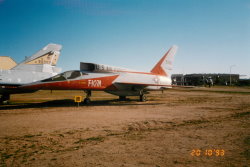
North American YF-107A Ultra Saber (NA-212, AF 51-5118) on display 8/3/2011 at the Pima Air and Space Museum, Tucson, Arizona (Photos by Lt. Col. Dr. Marc Matthews, M.D., USAF, retired) 3/small>


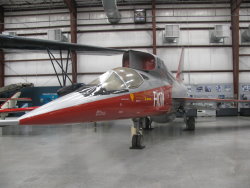
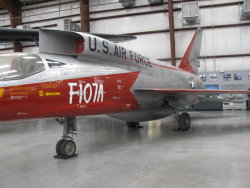
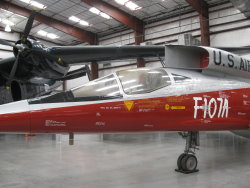
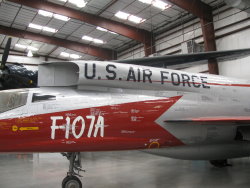
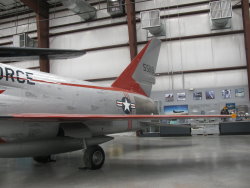
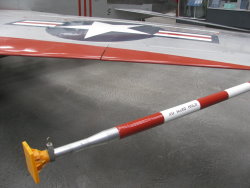
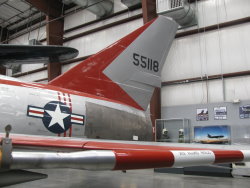

Overview 4
The North American YF-107A Ultra Sabre was North American Aviation’s (NAA) entry in a United States Air Force tactical fighter-bomber design competition of the 1950’s. The North American YF-107A Ultra Sabre incorporated many innovations and radical design features, and was based on the North American F-100 Super Sabre. The competition was eventually won by the Republic F-105 Thunderchief, and the North American YF-107A Ultra Sabre prototypes ended their lives as test aircraft.
Design and Development
In June 1953, North American initiated an in-house study of advanced F-100 Super Sabredesigns, leading to proposed interceptor (NA-211: F-100BI denoting "interceptor") and fighter-bomber (NA-212: F-100B) variants. Concentrating on the F-100B, the preliminary engineering and design work focused on a tactical fighter-bomber configuration, featuring a recessed weapons bay under the fuselage and provision for six hardpoints underneath the wings. Single-point refueling capability was provided while a retractable tailskid was installed. An all-moving vertical fin and an automated flight control system was incorporated which permitted the aircraft to roll at supersonic speeds using spoilers. The flight control system was upgraded by the addition of pitch and yaw dampers.
The aircraft’s most distinguishing feature is its dorsal-mounted variable-area inlet duct (VAID). While the VAID was at the time a system unique to the YF-107A, it is now considered to be an early form of variable geometry intake ramp which automatically controlled the amount of air fed to the jet engine. Although the preliminary design of the air intake was originally located in a chin position under the fuselage (an arrangement later adopted for the F-16), the air intake was eventually mounted in an unconventional position directly above and just behind the cockpit. The VAID system proved to be very efficient and NAA used the design concept on their A-5 Vigilante, XB-70 Valkyrie and XF-108 Rapier designs.
The air intake was in the unusual dorsal location as the USAF had required the carriage of an underbelly semi-conformal nuclear weapon. The original chin intake caused a shock wave that interfered in launching this weapon. The implications this had for the survivability of the pilot during ejection were troubling. The intake also severely limited rear visibility. Nonetheless this was not considered terribly important for a tactical fighter-bomber aircraft, and furthermore it was assumed at the time that air combat would be via guided missile exchanges outside visual range.
In August 1954, a contract was signed for three prototypes along with a pre-production order for six additional airframes.
Designation and Names
Extensive design changes resulted in its redesignation from F-100B to YF-107A before the first prototype flew. The F-107 was never given an official name, but was sometimes informally called the Super Super Sabre referring to North American’s earlier fighter design, the F-100 Super Sabre. The flight crews referred to it as the man eater, in reference to the position of the air intake directly above the cockpit.
The designation F-107A was the only one assigned to the aircraft, though YF-107A is often used in publications.
Operational History
The first YF-107A (s/n 55-5118) with North American’s chief test pilot Bob Baker at the controls, made its initial flight on 10 September 1956, attaining Mach 1.03. Although successfully carrying out its flight, the brake chute did not deploy, which resulted in a "hot" landing with the nose gear strut breaking. The aircraft first achieved Mach 2 in tests on 3 November 1956.
It was joined by the second YF-107A (s/n 55-5119), which made its first flight was on 28 November 1956. It was used for weapons testing with both conventional and atomic bombs. The last prototype, (s/n 55-5120) had its maiden flight on 10 December 1956. At the conclusion of the YF-107A’s successful test program, the Tactical Air Command decided to hold a fly-off competition between the YF-107A and the Republic F-105 which was designed to same mission requirements and used the same engine. Although the competition was close, the Republic F-105 Thunderchief was selected as the new standard TAC tactical fighter. The three YF-107A prototypes were relegated to test flying while the pre-production order was canceled.
In late 1957, prototypes #1 and #3 were leased to the National Advisory Committee for Aeronautics (NACA) for high-speed flight research, while aircraft #2 was flown on 25 November 1957 to the National Museum of the United States Air Force near Dayton, Ohio. In September 1959, with Scott Crossfield at the controls, aircraft #3 was damaged during an aborted takeoff. The aircraft was not repaired and, ultimately, it was used for fire fighting training and was destroyed in the early 1960’s.
Aircraft on Display
Specifications (YF-107A) 5
Type
Power Plant
Dimensions
Weights
Armament
Performance
Production
References